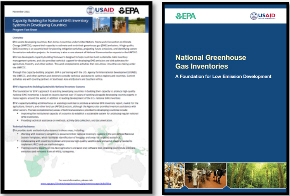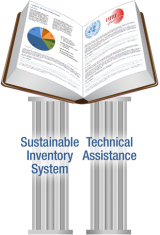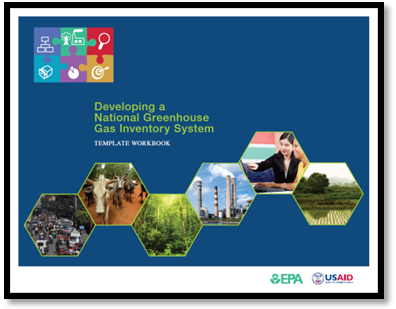National GHG Inventory Capacity Building
On This Page
- Approach to Building Sustainable Inventory Systems
- National System Templates
- Technical Assistance and Tools for Data Collection and Data Management
Developing GHG inventories is an essential first step toward managing emissions. EPA assists developing countries--Non-Annex I countries under United Nations Framework Convention on Climate Change (UNFCCC)--to improve their capacity to estimate and track their greenhouse gas (GHG) emissions. A complete and transparent national GHG inventory is an essential tool for understanding emissions and trends, projecting future emissions and identifying sectors for cost-effective emission reduction opportunities. A national inventory is also a core element of National Communication reports to the UNFCCC.
EPA has developed a capacity-building approach to help countries build sustainable GHG inventory management systems. The Agency also builds capacity through technical support to enhance data collection for estimating GHG emissions and sinks for agriculture, forestry, and other sectors. This work complements activities Exit that non-Annex I countries are taking under the UNFCCC.
Through this capacity-building program, EPA is partnering with the U.S. Agency for International Development (USAID), the UNFCCC, and other partners and donors to provide technical assistance in various regions and countries. EPA has ongoing activities with country partners in Southeast Asia, Eastern and Southern Africa, and will also participate in a multi-agency effort in the Andean Region.
Approach to Building Sustainable Inventory Systems
The foundation of EPA's approach to assisting developing countries in building their capacity to produce complete and transparent national GHG inventories is based on lessons learned over 15 years of working alongside developing country experts in many regions around the world, in addition to leading development of the U.S. national GHG inventory.
EPA's approach has two components. First, EPA works with each country to improve its institutional capacity to manage the GHG inventory compilation process and to establish a sustainable system for producing regular national GHG inventories. Second, EPA provides technical assistance in collecting data, developing analytical methods, and documenting the inventory process so that countries can continue to build upon their efforts for the future.
EPA provides tools and technical assistance to complement these two components, including:
- Working with inventory compilers to document their national inventory systems using the National System Templates, which facilitates identification of key gaps and areas for targeted assistance.
- Collaborating with countries to obtain and process high-quality satellite data and aerial imagery needed to implement IPCC land-use methodologies.
- Training country experts on the ALU (Agriculture and Land-Use National GHG Inventory) software tool, enabling countries to estimate emissions and removals from all AFOLU categories.
These tools, developed in conjunction with USAID, are consistent with UNFCCC reporting guidelines and are available through the links below. A number of key lessons have been learned and integrated into EPA's approach:
- A high level of technical expertise on the source and sink categories (forests, crops, livestock, energy, etc.) already exists in most developing countries. The challenge is to put this expertise to use in applying the IPCC methodologies to develop a high quality, well-documented inventory, and a sustainable inventory management system.
- Climate change teams in developing countries may face significant challenges, including:
- Small teams with multiple responsibilities and limited resources;
- Incomplete or missing activity data;
- Lack of country-specific emission factors;
- Insufficient documentation of methods and data sources used in previous inventories; and
- Difficulties retaining capacity and expertise developed during the preparation of previous National Communications.
- Host countries should lead the effort to set priorities for inventory improvements.
- GHG inventory capacity-building activities must be highly targeted, focusing on specific, measurable, and realistic outcomes with the ultimate goal of preparing a complete, transparent, accurate, consistent, and comparable national GHG inventory.
- A complete, transparent, well-documented GHG inventory provides a solid foundation for developing future national inventories.
National System Templates
A major component of U.S. EPA's approach is to build sustainable national GHG inventory management systems using the pre-defined National System Templates as a starting point. Completed templates can be compiled into a single National Inventory System Report, which provides a comprehensive documentation of each critical component for managing development of the GHG inventory development process. These tools are consistent with IPCC and UNFCCC guidelines for national GHG inventory development. This section describes and provides download links for each of the six individual templates, along with the Key Category Analysis Tool.
- Institutional Arrangements for National Inventory Systems (IA)
Institutional Arrangements for National Inventory Systems (.doc)(9 pp, 276 K)
En Español (.doc)(10 pp, 237 K)
En Français (.doc)(10 pp, 223 K)Assists inventory teams in assessing and documenting the strengths and weaknesses of existing institutional arrangements and to help plan arrangements for future inventory development to ensure continuity and integrity of the inventory, promote institutionalization of the inventory process, and facilitate prioritization of future improvements.
National GHG Inventory Toolkit
The materials listed below are part of EPA’s National GHG Inventory Toolkit, a supplementary resource to the National GHG Inventory System Template Workbooks. A number of the toolkit materials below can assist countries to operationalize and institutionalize the plans outlined in the Institutional Arrangements template. This Toolkit can be used by a national inventory team to help design and develop a sustainable inventory management system.
- National GHG Inventory Coordinator - Responsibilities and Qualifications:
Describes the roles and key responsibilities for the NIC in order to effectively manage and coordinate development of a National GHG Inventory.- National GHG Inventory Coordinator: Responsibilities and Qualifications (.docx)(3 pp, 83 K)
- En Español (.docx)(3 pp, 77 K)
- En Français (.docx)(3 pp, 80 K)
- Sector Roles and Responsibilities:
These documents describe the likely roles and key responsibilities for each sector lead for the National GHG Inventory (Energy; Industrial Processes and Product Use; Agriculture; Land Use, Land-Use Change, and Forestry; and Waste). The primary role of each Sector Lead is to manage and coordinate development of GHG emission estimates for their respective sector.- Agriculture (.docx)(3 pp, 65 K)
En Español (.docx)(3 pp, 59 K)
En Français (.docx)(3 pp, 61 K) - Energy (.docx)(3 pp, 67 K)
En Español (.docx)(3 pp, 58 K)
En Français (.docx)(3 pp, 61 K) - Industrial Processes (.docx)(3 pp, 67 K)
En Español (.docx)(3 pp, 58 K)
En Français (.docx)(3 pp, 61 K) - LULUCF (.docx)(3 pp, 65 K)
En Español (.docx)(3 pp, 58 K)
En Français (.docx)(3 pp, 59 K) - Waste (.docx)(3 pp, 68 K)
En Español (.docx)(3 pp, 57 K)
En Français (.docx)(3 pp, 61 K)
- Agriculture (.docx)(3 pp, 65 K)
- Confidentiality Agreement and Amendment Template:
Provides a template for an agreement between a ministry developing GHG estimates and a data provider that is supplying confidential business information (CBI) for the development of GHG estimates.- Confidentiality Agreement and Amendment Template (.docx)(5 pp, 43 K)
- En Español (.docx)(5 pp, 52 K)
- En Français (.docx)(5 pp, 50 K)
- Memorandum of Understanding Template:
Provides a template for an agreement between two entities working on the national GHG inventory, such as a ministry developing GHG estimates and a data provider.- Memorandum of Understanding Template (.docx)(5 pp, 38 K)
- En Español (.docx)(5 pp, 37 K)
- En Français (.docx)(5 pp, 49 K)
- Contact Form and Supplemental Information:
Form to record personal communications, telephone conversations or serve as a cover sheet for email or facsimile communications.- Contact Form and Supplemental Information (.docx)(3 pp, 37 K)
- En Español (.docx)(3 pp, 30 K)
- En Français (.docx)(3 pp, 59 K)
- Inception Memorandum:
Standardized template for drafting a National Inventory Inception Memorandum, which can be customized and distributed by a country's National Inventory Coordinator to provide guidance to those working on the National GHG inventory.- Inception Memorandum (.docx)(19 pp, 580 K)
- En Español (.docx)(19 pp, 620 K)
- En Français (.docx)(19 pp, 605 K)
- Sample Statement of Work:
Template for drafting a Statement of Work (SOW) that can be used by a lead inventory agency to develop a request for proposal/task order request.- Sample Statement of Work (.docx)(23 pp, 521 K)
- En Español (.docx)(23 pp, 549 K)
- National GHG Inventory Coordinator - Responsibilities and Qualifications:
- Methods and Data Documentation (MDD)
Methods and Data Documentation (.doc)(8 pp, 204 K)
En Español (.doc)(8 pp, 191 K)
En Français (.doc)(8 pp, 171 K)Assists inventory teams in documenting and reporting the origin of methodologies, activity datasets, and emission factors used to estimate emissions or removals. Future inventory teams can refer to the completed template for each source and sink category to determine what information was collected, how the data were obtained, and what methods were used, as well as to reproduce estimates.
- Description of Quality Assurance and Quality Control Procedures (QA/QC)
Description of Quality Assurance and Quality Control Procedures (.doc)(16 pp, 246 K)
En Español (.doc)(16 pp, 302 K)
En Français (.doc)(16 pp, 239 K)Guides countries through the establishment of a cost-effective QA/QC program to improve transparency, consistency, comparability, completeness, and confidence in national GHG inventories. The template includes supplemental checklists with recommended QA/QC procedures that are specific to management roles, such as the Inventory Coordinator and QA/QC Coordinator, as well as sector leads.
- Description of Archiving System (AS)
Description of Archiving System (.docx)(10 pp, 70 K)
En Español (.docx)(10 pp, 195 K)
En Français (.docx)(10 pp, 165 K)Facilitates reproducing and updating GHG emission estimates to be easily recreated, safeguards against data and information loss, and facilitates development of subsequent inventories by future inventory staff. An archive system is an inexpensive yet critical step toward a sustainable National Inventory System.
- Key Category Analysis (KCA)
Key Category Analysis (.doc)(15 pp, 1 MB)
En Español (.doc)(10 pp, 410 K)
En Français (.doc)(10 pp, 249 K)Identifies the sources and/or sinks that have the greatest contribution to national emissions, and thus should be the focus of improvement efforts. The template and tool are consistent with IPCC Guidelines. The KCA Tool enables a country to determine key categories from GHG inventory estimates.
Key Category Analysis Tool (.xls)(1 pg, 3 MB)
En Español (.xls)(1 pg, 4 MB)
En Français (.xls)(1 pg, 4 MB)
- National Inventory Improvement Plan (NIIP)
National Inventory Improvement Plan (.docx)(11 pp, 87 K)
En Español (.docx)(12 pp, 199 K)
En Français (.docx)(12 pp, 188 K)Synthesizes findings and describes specific priorities for future capacity-building projects based on the needs identified in the first five templates, and facilitates continual inventory improvements.
Technical Assistance and Tools for Data Collection and Data Management
EPA assists countries to overcome data collection barriers and enhance their capacity to transition to higher-tier methods for key categories There are two general parts to this approach:
- Identification of data needs and strategies: EPA works with national experts to identify critical data needs for applying the IPCC methods and then assists them with assembling the data.
- Software tools: EPA has supported the development of software tools that simplify the task of estimating emissions from agriculture, land-use change and forestry, and solid waste.
Data Collection for the Agriculture, and Land Use, Land-use Change and Forestry (LULUCF) Sectors
This sector is an important source and sink of emissions for many developing countries, but managing the large amount of data and ensuring appropriate cross-linkages where data is shared among different source/sink categories can be an overwhelming task. To assist developing countries in this task, EPA and Colorado State University have developed the ALU Exit (Agriculture and Land-Use) software tool. The ALU tool enables countries to estimate emissions and removals from all agricultural and land-use source categories, using either IPCC Tier 1 or Tier 2 methods from the 1996 IPCC Guidelines as updated by the 2000 and 2003 IPCC Good Practice Guidance. Associated with the tool are specific activity data workbooks that assist inventory compilers in compiling the required data for implementing the IPCC methodologies.
The newly updated FAOSTAT Exit emission database provides country-level estimates of greenhouse gas (GHG) emissions based on FAOSTAT activity data and using Tier 1 computations for the Agriculture, Forestry, and Other Land Use sectors. The database contains updated historical estimates for 1961 through 2011 as well as projections to 2030 and 2050, and for Land Use from 1990 through 2010.
Geographic Information Systems (GIS) & Remote Sensing Data Collection
A requirement for developing a national GHG Inventory for land use, land-use change and forestry utilizing the IPCC Guidelines is a complete and consistent representation of a countries land-base broken out by the six IPCC land use categories (Forest Land, Cropland, Grassland, Settlements, Wetlands and Other Lands). These six main land use categories are then sub-categorized to the level (e.g., forest types, crop systems, grassland types) at which the inventory estimates will be developed. EPA is working with developing countries to obtain and process high-quality satellite data and aerial imagery needed to implement these IPCC land-use methodologies. Assistance varies by country but ranges from improving the accuracy of existing maps to full map production, quality assurance, and evaluation. Once geographic data are complete, EPA works with each country to input the processed data into the ALU tool to estimate emissions and removals from land use, land-use change and forestry.
Data Collection for the Waste Sector
As developing countries increase reliance on sanitary landfills to manage wastes, methane emissions from solid waste disposal become an important source of emissions. EPA has worked with countries to improve collection of data on waste composition and disposal practices. The data can then be input into the 2006 IPCC Waste Model Exit to develop GHG estimates from this source. Data can also be shared with other regions through the IPCC Emission Factor Database Exit.
In addition, data collected from some regions as part of this work were used to customize the International Landfill Gas Model, which estimates landfill gas generation from landfills, potential landfill gas recovery, and methane emission reductions.



